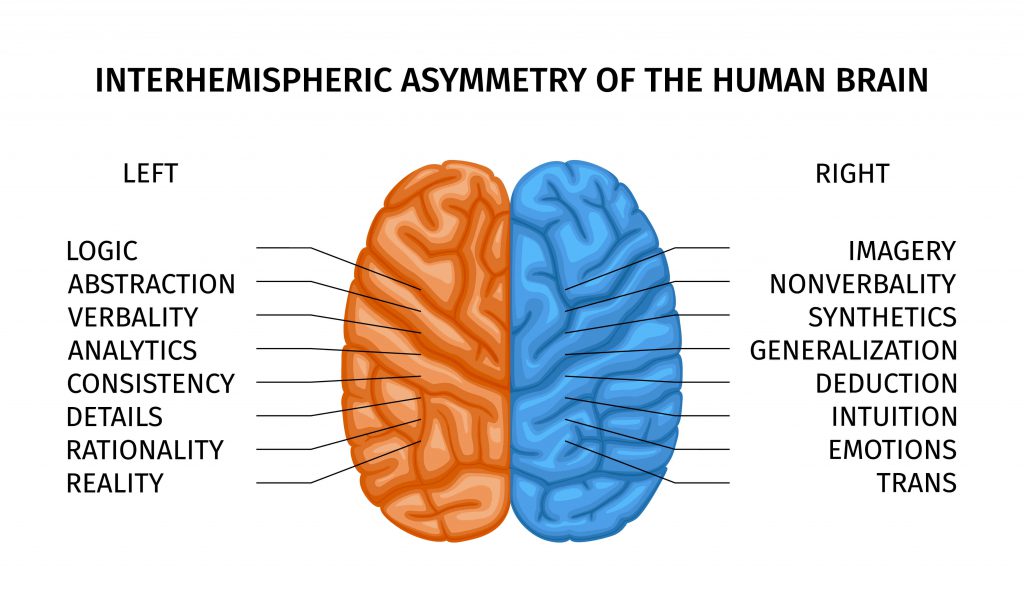Brain Hemispheric Collaboration
The human brain, a marvel of biological engineering, is divided into two distinct hemispheres: the left and the right. While early research suggested a strict division of labor, with the left handling logic and the right creativity, modern neuroscience paints a far more nuanced picture. The reality is that these two hemispheres are in constant communication, working in intricate collaboration to produce our complex cognitive functions. This article delves into the fascinating world of brain hemispheric collaboration, exploring how these two halves work together to create a unified conscious experience.
Time to feel better. Find a mental, physical health expert that works for you.
The Corpus Callosum: The Bridge Between Hemispheres
The primary conduit for communication between the left and right hemispheres is the corpus callosum, a massive bundle of nerve fibers. This structure allows for the rapid transfer of information, enabling the hemispheres to share data and coordinate their activities. Without it, the brain’s ability to integrate sensory input, motor control, and cognitive processes would be severely compromised.
Dynamic Interactions:
It’s crucial to understand that while some functions may be lateralized (meaning they are more dominant in one hemisphere), most cognitive tasks involve both hemispheres. For example:
- Language:
- While the left hemisphere is typically dominant for language production and comprehension, the right hemisphere plays a vital role in understanding nuances like intonation, sarcasm, and emotional tone.
- Therefore, a complete language experience requires both hemispheres.
- Visual Processing:
- Each hemisphere processes visual information from the opposite visual field.
- The corpus callosum then integrates these separate inputs to create a unified visual perception.
- Motor Control:
- The left hemisphere controls the right side of the body, and vice versa.
- Complex motor tasks, like playing a musical instrument, require precise coordination between both hemispheres.
- Emotional Processing:
- While older theories placed emotion solely in the right hemisphere, modern research shows that both hemispheres are invloved.
- The right hemisphere is involved in processing negative emotions, and the left in processing positive emotions.
- Emotional regulation requires collaboration between both sides.
The Importance of Integration:
The seamless integration of hemispheric functions is essential for:
- Unified Consciousness:
- Our subjective experience of the world is a unified whole, thanks to the constant communication between the hemispheres.
- Complex Problem Solving:
- Many problems require both logical analysis (left hemisphere) and creative insight (right hemisphere).
- Collaboration allows us to approach challenges from multiple perspectives.
- Adaptability:
- The brain’s ability to adapt to new situations relies on the flexible interplay between the hemispheres.
Research and Discoveries:
Studies on “split-brain” patients, individuals who have had their corpus callosum severed, have provided valuable insights into hemispheric specialization and collaboration. These studies have revealed that:
- Each hemisphere can function independently to some extent.
- However, the lack of communication leads to difficulties in tasks that require integration.
- These studies have assisted in the understanding of how the brain creates a unified consiousness.
The notion of a strictly divided brain is a simplification. The reality is a dynamic network of interconnected regions, with the left and right hemispheres working in constant collaboration. This intricate interplay is fundamental to our cognitive abilities, shaping our perception, thoughts, and actions. Continued research in this area will undoubtedly reveal even more about the remarkable complexity of the human brain.
Connect Free. Improve your mental and physical health with a professional near you

Cognitive Specialization: Myth and Reality
The concept of “left-brained” versus “right-brained” individuals has permeated popular culture, suggesting that people are either logical and analytical or creative and intuitive. However, this simplistic dichotomy is far from the truth. Modern neuroscience has debunked the idea of rigid hemispheric specialization, revealing a far more integrated and dynamic brain. This article explores the myth of cognitive specialization and the reality of how our brains function.
The Origin of the Myth:
The left-brain/right-brain myth originated from research in the 1960s by Roger Sperry, who studied split-brain patients. His work revealed that the hemispheres have some specialized functions. For example, the left hemisphere is typically dominant for language, while the right hemisphere is involved in spatial reasoning. However, these findings were often oversimplified and misinterpreted.
Debunking the Dichotomy:
Neuroimaging studies have consistently shown that:
- Both hemispheres are involved in virtually all cognitive tasks.
- There is no evidence to support the idea that individuals predominantly use one hemisphere over the other.
- Brain functions are distributed across complex neural networks, not confined to single hemispheres.
The Reality of Brain Function:
Instead of rigid specialization, the brain exhibits:
- Lateralization:
- Some functions are indeed lateralized, meaning they are more dominant in one hemisphere.
- However, this does not mean that the other hemisphere is inactive.
- Integration:
- The corpus callosum facilitates constant communication between the hemispheres, allowing for seamless integration of information.
- This integration is essential for complex cognitive processes.
- Neuroplasticity:
- The brain is highly adaptable, capable of rewiring itself in response to experience.
- This plasticity allows for the development of diverse cognitive skills.
The Dangers of the Myth:
The left-brain/right-brain myth can have detrimental effects:
- Limiting Potential:
- It can lead people to believe that they are inherently good at certain things and bad at others, limiting their potential.
- Misguided Education:
- It can result in educational practices that cater to perceived “learning styles,” which have been shown to be ineffective.
- False understanding of cognitive functions:
- This myth, gives a false understanding of the brains true complexity.
Embracing the Whole Brain:
Instead of focusing on a false dichotomy, we should embrace the holistic nature of brain function. Developing cognitive skills requires engaging the entire brain, fostering both analytical and creative abilities.
The left-brain/right-brain myth is a simplification of a complex reality. The human brain is a highly integrated and dynamic organ, with both hemispheres working in constant collaboration. Understanding this holistic view can empower us to develop our full cognitive potential and appreciate the remarkable complexity of the human mind.

Free consultations. Connect free with local health professionals near you.
Conclusion
In the intricate tapestry of neuroscience, the exploration of brain hemispheric function has undergone a profound transformation. What began as a seemingly straightforward division of labor between the left and right hemispheres has evolved into a nuanced understanding of dynamic collaboration. The initial concept of rigid cognitive specialization, encapsulated by the “left-brained” and “right-brained” myth, has been dismantled by the weight of empirical evidence, revealing a brain that thrives on integration and interconnectedness.
The most critical takeaway is the realization that the human brain operates as a unified whole. While lateralization, the tendency for certain functions to be more dominant in one hemisphere, does exist, it does not imply isolation. Language, often cited as a left-hemisphere function, necessitates the right hemisphere’s contribution to comprehending emotional nuances and contextual cues. Similarly, spatial reasoning, a right-hemisphere domain, is enhanced by the left hemisphere’s analytical precision.
The corpus callosum, the brain’s information superhighway, plays an indispensable role in this collaborative dance. Its efficient transfer of data ensures that both hemispheres are constantly informed and synchronized, enabling the seamless execution of complex cognitive tasks. From the mundane act of catching a ball to the profound experience of artistic expression, the brain orchestrates a symphony of neural activity, where both hemispheres contribute their unique strengths.
The debunking of the left-brain/right-brain myth is not merely an academic exercise; it has profound implications for how we perceive and cultivate cognitive potential. This myth, with its simplistic categorization, can inadvertently limit individuals’ aspirations. It suggests that certain talents are innate and fixed, discouraging the pursuit of skills deemed outside one’s “natural” domain. However, the reality of neuroplasticity, the brain’s remarkable ability to rewire itself, underscores that cognitive abilities are malleable and can be developed through deliberate practice.
Moreover, educational practices informed by the myth of distinct learning styles have proven ineffective. The idea that individuals learn best when taught in a manner that aligns with their perceived hemispheric dominance is a fallacy. Instead, a holistic approach that engages the entire brain, fostering both analytical and creative thinking, is far more conducive to learning.
Understanding the integrated nature of brain function also sheds light on the complexities of neurological conditions. Studies of split-brain patients, while initially contributing to the myth of hemispheric specialization, have ultimately revealed the brain’s remarkable adaptability. Even in the absence of the corpus callosum, the brain can find alternative pathways for communication, albeit with limitations. This adaptability underscores the brain’s resilience and its capacity for reorganization.
In essence, the conclusion we draw is one of interconnectedness and dynamic interplay. The human brain is not a collection of isolated modules but a complex network where every region, including the left and right hemispheres, contributes to the overall cognitive experience. Embracing this holistic view allows us to appreciate the brain’s remarkable capacity for integration, adaptability, and creativity.
Moving forward, research should continue to explore the intricate mechanisms of hemispheric collaboration, delving into the specific neural pathways and molecular processes that facilitate communication between the hemispheres. This deeper understanding will not only enhance our knowledge of brain function but also pave the way for innovative interventions to address neurological disorders and optimize cognitive performance.
Ultimately, the journey from a simplistic dichotomy to a nuanced understanding of brain function reflects the broader trajectory of scientific inquiry. As we continue to unravel the mysteries of the brain, we move closer to a more accurate and comprehensive appreciation of the most complex organ in the human body.
Time to feel better. Find a mental, physical health expert that works for you.
Common FAQs
Is it true that some people are "left-brained" and others are "right-brained"?
No, this is a common misconception. While the brain does have some specialized functions in each hemisphere, everyone uses both sides of their brain. The idea that people predominantly use one side or the other is a myth.
What does the left hemisphere of the brain do?
The left hemisphere is typically dominant for language processing (grammar, vocabulary), logical reasoning, analytical thinking, and sequential processing. It’s often associated with tasks like mathematics and science.
What does the right hemisphere of the brain do?
The right hemisphere is often associated with spatial reasoning, visual processing, creativity, intuition, and emotional processing. It plays a role in recognizing faces, understanding emotions, and appreciating music and art.
How do the two hemispheres of the brain communicate?
The two hemispheres communicate through the corpus callosum, a large bundle of nerve fibers that connects them. This allows for the rapid transfer of information between the hemispheres, enabling them to work together.
If the left-brain/right-brain theory is a myth, why is it so popular?
The theory gained popularity because it offered a simple explanation for complex cognitive differences. However, it oversimplified the brain’s functions. Early research on split-brain patients contributed to the myth, but later studies have shown that the brain is far more integrated.
Are there any real differences between the hemispheres?
Yes, there are some functional differences. For example, language is typically more dominant in the left hemisphere, and spatial reasoning in the right. However, these differences don’t mean that one hemisphere works independently of the other.
How does understanding the integrated brain affect education?
Can I strengthen one side of my brain more than the other?
While you can develop specific skills associated with each hemisphere (e.g., language skills for the left, artistic skills for the right), you can’t truly isolate one hemisphere. Developing any skill involves the entire brain, due to the constant communication between hemispheres.
What are some examples of tasks that require both hemispheres to work together?
Many complex tasks require both hemispheres. Examples include:
* Playing a musical instrument (combining motor skills and musical interpretation)
* Solving complex problems (requiring both logic and creativity)
* Understanding language in context (combining grammar with emotional cues)
What are some current areas of research related to brain hemispheric
Current research focuses on:
People also ask
Q: What is the left and right brain?
A: He has been published in peer-reviewed journals, including the Journal of Clinical Psychology. The left brain is associated with logic, analytical thinking, and language processing, while the right brain is linked with creativity, intuition, and holistic thinking.
Q: What is a right brain person like?
A: Those who are left-brain dominant tend to have numeracy, logic, or critical thinking abilities, whereas those who are right-brain dominant tend to have creative talent, diplomacy, or imagination
Q: Are humans right-brained or left-brained?
A: It’s absolutely true that some brain functions occur in one or the other side of the brain. Language tends to be on the left, attention more on the right. But people don’t tend to have a stronger left- or right-sided brain network.
Q: What is left-brain weakness?
A: The brain’s left hemisphere controls the motor functions of the right side of the body. Therefore, damage to the left hemisphere can lead to weakness or paralysis on the right side, known as hemiparesis or hemiplegia. This can affect movement, coordination, and balance.
NOTICE TO USERS
MindBodyToday is not intended to be a substitute for professional advice, diagnosis, medical treatment, or therapy. Always seek the advice of your physician or qualified mental health provider with any questions you may have regarding any mental health symptom or medical condition. Never disregard professional psychological or medical advice nor delay in seeking professional advice or treatment because of something you have read on MindBodyToday.
Share this article

Let us know about your needs

Quickly reach the right healthcare Pro

Message health care pros and get the help you need.
Popular Healthcare Professionals Near You
You might also like
What is Learned Helplessness?
, What is Learned Helplessness? Everything you need to know Find a Pro Expanding on Learned Helplessness Learned helplessness, as […]
What is Left Brain – Right…
, What is Left Brain – Right Brain? Everything you need to know Find a Pro Brain Hemispheric Collaboration The […]
What is Loneliness?
, What is Loneliness? Everything you need to know Find a Pro Loneliness: Prevention and Health Impacts Loneliness, a deeply […]





